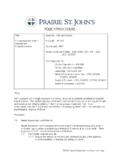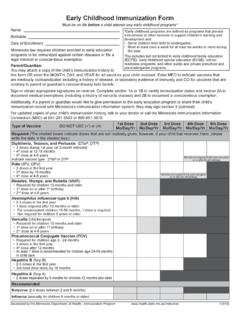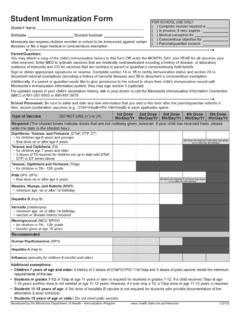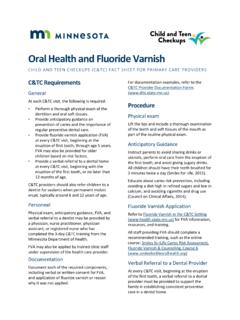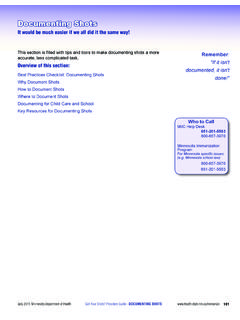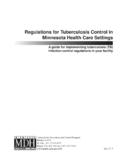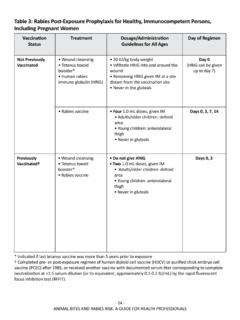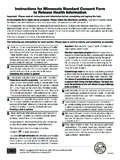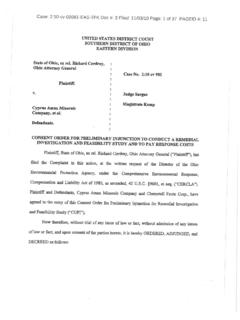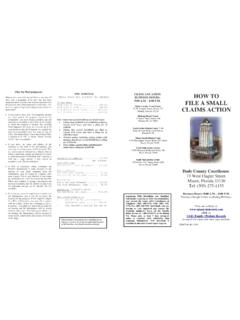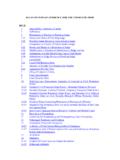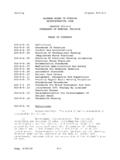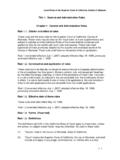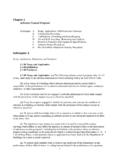Transcription of “Choice Information on the regulations and requirements of ...
1 Updated 01/2011 1 Choices Information on the regulations and requirements of the final disposition of a dead human body i n minnesota . minnesota department of health Mortuary Science Section 85 East Seventh Place, Suite 220 Box 64882 St. Paul, MN 55164-0882 (651) 201-3829 TDD: (651) 201-5797 Updated 01/2011 2 Table of Contents Right to Control and Duty of the Disposition of the Reporting a Removing a Dead Human Body from a Place of Filing a Death Disposition Certified Copies of the Death Tangible Public Private Green Funerals/Green Ceremonies and Choosing a Funeral Required Price Lists and Death Outside the Air Crossing State Pre-Planning a County Social Security Veteran Fetal Death and Infant Consumer Organizations Accepting Donations in Introduction The Mortuary Science Section receives Information requests from a variety of people, including the public.
2 Who wish to take care of the funeral process on their own and those who wish to use a mortician. The Section also receives questions from coroners and medical examiners, law enforcement personnel, attorneys, county registrars, hospitals and nursing homes, physicians and nurses, medical records staff, funeral home and crematory owners, morticians, and cemeteries. In an effort to provide Information to this broad range of people, the Mortuary Science Section staff has put together this manual answering the questions most commonly asked. Updated 01/2011 3 Death touches everyone eventually, and when it does, there are many important decisions to make. Whether one decides to use a funeral home or care for a loved one independently, there is much to do.
3 This manual addresses the necessary duties, possible choices and legal requirements that must be met when a death occurs. Please note that a glossary of terms is provided at the end of this manual. It may be helpful to read the glossary first to become familiar with these terms. Right to Control and Duty of the Disposition of the Body minnesota law clearly identifies who is in charge of the disposition of the body. The right to control a dead human body, including the location and conditions of final disposition, vests in, and the duty of final disposition of the body devolves upon, the following in the order of priority listed: 1) a person may plan for their own final disposition and have those wishes carried out; (These arrangements made in advance of need must be in writing, dated and witnessed.
4 2) the person or persons appointed in a dated written instrument signed by the decedent. By definition, a written instrument includes, but is not limited to, a health care directive executed under chapter 145C. If there is a dispute involving more than one written instrument, a written instrument that is witnessed or notarized prevails over a written instrument that is not witnessed or notarized. However, a written instrument does not include a durable or nondurable power of attorney which terminates on the death of the principal pursuant to sections and ; 3) the spouse of the decedent; 4) the adult child or the majority of the adult children of the decedent. Keep in mind that, in the absence of actual knowledge to the contrary, a mortician may rely on instructions given by the child or children who represent that they are the sole surviving child, or that they constitute a majority of the surviving children; 5) the surviving parent or parents of the decedent, each having equal authority; 6) the adult sibling or the majority of the adult siblings of the decedent, provided that, in the absence of actual knowledge to the contrary, a mortician may rely on instructions given by the sibling or siblings who represent that they are the sole surviving sibling, or that they constitute a majority of the surviving siblings.
5 Updated 01/2011 4 7) the adult grandchild or the majority of the adult grandchildren of the decedent. A mortician may rely on instructions given by a grandchild or grandchildren who represent that they are the only grandchild or grandchildren reasonably available to control final disposition of the decedent's remains or represent a majority of such grandchildren; 8) the grandparent or the grandparents of the decedent, each having equal authority; 9) the adult nieces and nephews of the decedent, or a majority of them, provided that, in the absence of actual knowledge to the contrary, a funeral director or mortician may rely on instructions given by a niece, nephew, or nieces or nephews who represent that they are the only niece, nephew, or nieces or nephews reasonably available to control final disposition of the decedent's remains or represent a majority of nieces and nephews reasonably available to control final disposition of the decedent's remains.
6 10) the person or persons who were acting as the guardians of the person of the decedent with authority to make health care decisions for the decedent at the time of death; 11) an adult who exhibited special care and concern for the decedent; 12) the person or persons respectively in the next degree of kinship in the order named by law to inherit the estate of the decedent; and 13) the appropriate public or court authority, as required by law. You may review the regulations on controlling the final disposition of a body and who has the duty to pay for the funeral in MN Statutes Reporting a Death When a death occurs outside a care facility, such as a hospital or a nursing home, minnesota statute requires that the death must be reported to the local coroner or medical examiner.
7 This means that all deaths occurring at home must be reported. A family member, a hospice worker, emergency medical service personnel, law enforcement personnel or a mortician can do this. Failure to report a death will cause problems with getting a death certificate completed. minnesota statute states that whoever interferes with the body or scene of death with intent to mislead the coroner or medical examiner or conceal evidence is guilty of a gross misdemeanor. Updated 01/2011 5 The name and contact Information of a local coroner or medical examiner can be found in the Government section in the front of a telephone book or on-line at Autopsy An autopsy may be required by the coroner or medical examiner, at no cost, if there is any question about the cause or manner of death.
8 A physician may ask permission to do an autopsy to confirm or clarify a diagnosis. The family of the deceased may request an autopsy. When requested by the family, a fee for the autopsy may be charged. Donation Donation of tissue and organs saves the lives of thousands of men, women, and children each year. According to LifeSource , a single donor can help save and heal the lives of up to 60 people. Yet more than 109,000 people currently are on waiting lists for organ transplant. To learn more about donating tissue or organs for transplant, contact LifeSource at or American Donor Services at A person may also donate his/her body for education and research. Whole body donation to this cause will aid in anatomy education, research, clinical practice, surgical training, and biomedical device design.
9 In minnesota , there are two in-state options to which you may donate your body: 1) The University of minnesota Anatomy Bequest Program: 2) The Rochester Mayo Clinic: In rare cases, a donation may be declined. Contact a program of choice in advance to register and make alternative plans with family in the event a donation does not qualify. Removing a Dead Human Body from a Place of Death Unpaid persons with the right to control the dead human body, or that person's unpaid designee, may remove a body from the place of death, transport the body, prepare the body for disposition, or arrange for final disposition of the body. All actions must comply with regulations for final disposition found in minnesota Statutes 149A.
10 Only a licensed mortician may prepare a body for final disposition by embalming. When removing a deceased human body from a place of death, there are certain requirements to follow: Updated 01/2011 6 1) A Certificate of Removal is required any time there is a transfer of custody ofa dead human body from one entity to another. This form is available on-line at: 2) The deceased must be wrapped with a nonporous (plastic) ) A cot, stretcher or rigid tray must be used when moving the ) The body must be transported in a vehicle that has ample enclosed area forthe body to lay in a horizontal position, and it must be able to shield the body from public view. Nursing homes, hospitals, healthcare facilities and coroners/medical examiner offices are allowed by law to have a policy that restricts or limits who may remove the body from their facility.
